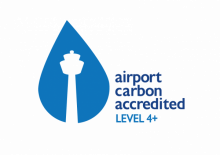On track for a greener, more sustainable air transport future

Charleroi airport, a pillar of Belgium's air transport industry, has marked a further step in its journey towards sustainability by achieving level 3 of the Airport Carbon Accreditation. In just two and a half years since joining this environmental program, the airport has made giant strides in reducing its carbon footprint and playing an active role in the fight against climate change. This success has been made possible by the unwavering commitment of its partners and the implementation of thoughtful measures.
International recognition of environmental commitment
Airport Carbon Accreditation, developed by Airport Council International (ACI), is the only independent international program to assess and recognize airports' efforts to reduce carbon emissions. It is divided into six levels, each representing an increasing level of environmental performance. Level 3, also known as "Optimization", represents a significant step towards carbon neutrality, involving a substantial reduction in the airport's direct and indirect emissions.
Encouraging results
Charleroi Airport joined the program in November 2020, with the ambitious aim of improving its environmental performance through a series of targeted initiatives. By reaching level 3, the airport has demonstrated its ability to implement effective strategies.
Among the key measures taken to achieve this level of environmental performance are the following:
- Energy efficiency: The airport has invested in technologies and practices to reduce its energy consumption, and has succeeded! Between 2019 and 2022, electricity consumption will be reduced by 13%. Improvements have been made to lighting systems (LED), as well as the installation of photovoltaic panels.
- An impressive result: Over the same period, a spectacular 50% reduction in water consumption testifies to the airport's commitment to minimizing its impact on precious resources.
- Sustainable transport: By working with local partners, the airport continually promotes the use of public transport and soft or collective mobility solutions for travellers to and from the airport.
- Improving the vehicle fleet: Currently, 30% of airside vehicles are electric, a crucial step in reducing emissions and dependence on fossil fuels. The airport is committed to maintaining this trend, ensuring that every new vehicle is at least electric.
- Collaboration: The active and determined participation of the airport's partners has played a major role in this development, from airlines and transport companies to retail outlets. They have all committed to a clear plan of action to continue their ecological efforts on a daily basis.
In its quest to reduce carbon emissions, Charleroi airport, in collaboration with all those involved in the air transport sector, has rethought its approach procedures for aircraft. This has not only helped to reduce noise, but has also succeeded in minimizing fuel consumption, bringing environmental benefits and a greater sense of well-being for nearby residents. But it won't stop there, and the airport is constantly striving to improve its operations with regard to local residents.
An inspiring story
Charleroi Airport's success in achieving level 3 of the Airport Carbon Accreditation is a significant testament to the airport industry's commitment to sustainability, and recognition by an independent body. It demonstrates that even in a traditionally energy-intensive sector, bold action and determination can lead to tangible results.
Charleroi airport has no intention of stopping there. Having achieved level 3, it now has its sights set on level 4. This new phase will involve additional challenges, but the airport remains determined to play an important role in the transition to a more sustainable future.
In conclusion, the story of Charleroi Airport illustrates how an initial commitment to sustainability, backed by concrete actions and a strategic approach, can lead to outstanding achievements in reducing carbon emissions. It reminds us that environmental innovation is a possible path to a cleaner, more responsible aviation future.



